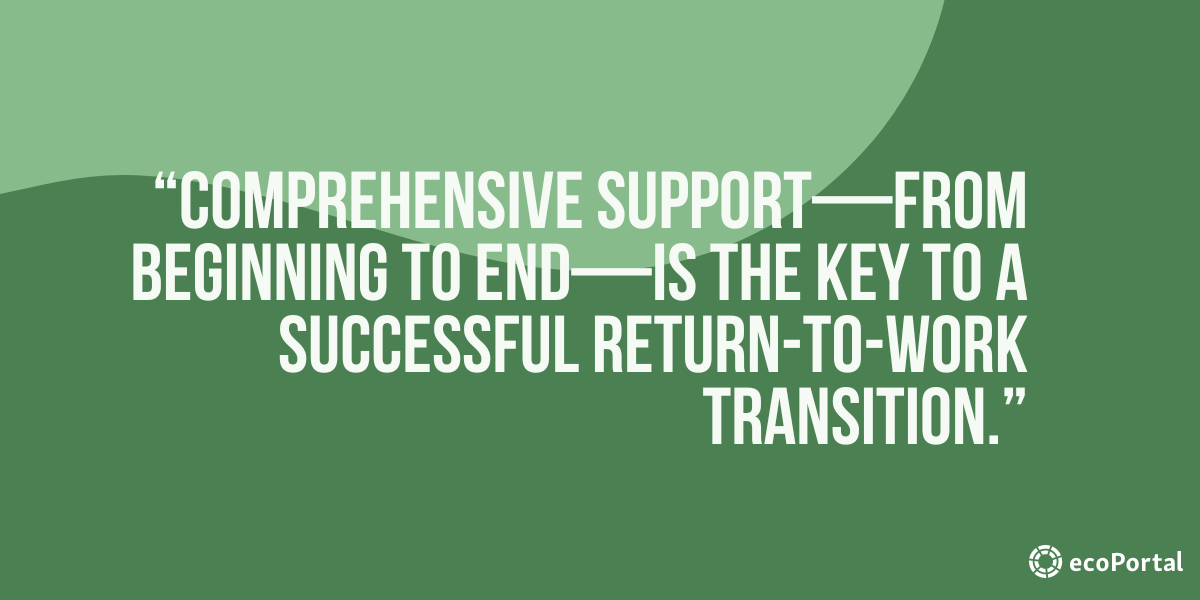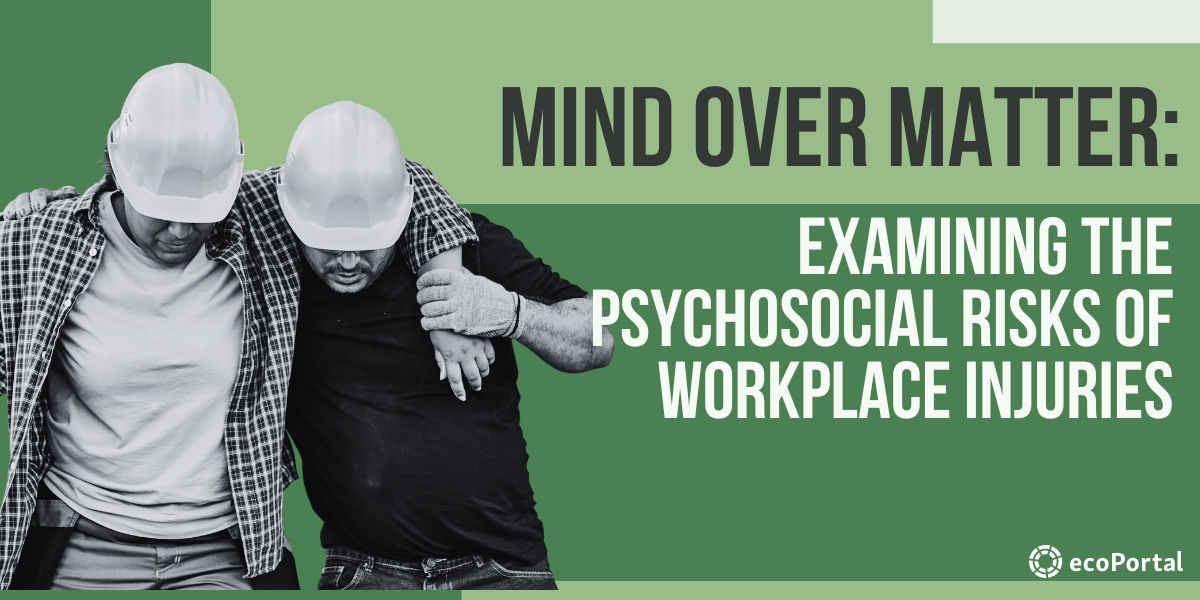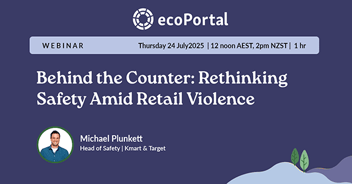What does your workplace do when someone gets hurt?
It’s not uncommon for injuries to be perceived through a purely physical lens. In fact, it’s intuitive that this occurs. When someone hurts themselves, the first thing to concern ourselves with is how severe the injury is, and manage their physical symptoms. Whether in or out of the workplace, this is a common approach to injury.
There’s little time given, however, to the overarching psychosocial impact of a workplace injury. We’re often preoccupied with examining an injury from a physical lens so much so, that we neglect to give adequate weight and time to the mental lens.
It’s time to change that.
Health and safety expert Giselle Phillips considers analysis of psychosocial risk an inherent part of risk management.
“Organisations should look at psychosocial risk factors as aspects of work design and business, as well as the social and interpersonal contexts of work.” she explains. “This way, you can understand exactly where adverse effects lie, and how they might impact workers’ mental health and overall wellbeing.”
It’s key that organisations understand the common psychosocial risk factors that arise when a worker gets hurt, and how this focus translates into workplace design.
Get fresh H&S insights weekly
What’s the relevance of focusing on psychosocial risks?
Risks are an inherent part of life and living. Typical workplace protocols focus heavily on tangible, physical risks, ones that may be encompassed in a workplace health and safety management system.
Psychosocial risks include anything that can have a tangible, negative impact on mental wellbeing.
When someone gets hurt at work, there are numerous psychosocial risk factors to become aware of.
“We need to acknowledge the interconnectedness of physical and psychological wellbeing in the return-to-work process.” adds Giselle, “The two go hand in hand.”
These risks include stress, social isolation, and work-related pressure—to name a few. When these psychosocial risks increase, their effects are significant, leading to decreased mental wellbeing and even anxiety or depression.
Here are some common psychosocial risks specifically associated with workplace injury:
Stress - especially when returning to the place of injury; or activity of injury.
Fear is our brain’s natural response to a situation that offers a threat to our physical or mental health. From all the way back to the Ice Age to now, fear has served as a guidance system, set in place to keep us out of the jaws of a sabre tooth tiger.
A small degree of stress has its place in the working world. Healthy stress keeps us motivated and can energise people to meet deadlines.
However, when an injury occurs, persistent stress—especially when returning to the site of injury—can take its toll.
Depending on the severity of the injury, the injured person might still hold some trauma associated with the impact of the injury. When the time rolls around to get back into normal work again, the injured person might experience greater than normal levels of anxiety or stress, and struggle to feel as confident as they did previously.
Worklessness
While time away from work is often sought after - typically a perk! - in the case of a workplace injury, forced, extensive time away from the workplace can bear a heavy weight on an individual’s mental wellbeing.
This can exacerbate feelings of despair and hopelessness, taking away from a sense of purpose. If the injury could have a significant impact on a worker’s ability to continue doing the work they were doing previously, this could lead to perceived hopelessness about the future.
If their job is a hands-on physical activity, being forced to be sedentary at home can be a real mental struggle.
Social isolation
Recovering from an injury can take more than just your physical abilities away. Spending long periods of time at home, away from the office or worksite, means a lot of time spent alone with your thoughts.
Being away from the hustle and bustle of a workplace means less contact time with others. If the individual’s partner or family go to work or school, they can spend unexpected hours by themselves, recovering from their injury.
While rest is a critical component to physical healing, extended social isolation can have long-standing negative impacts, creating fertile soil for rumination, anxious thinking, or depression.
How do we —as leaders—help?
Maintaining a laser focus on the psychosocial risks:
At a holistic level, it’s critical that we maintain a laser focus on all possible psychosocial risks, with regular evaluation and analysis. Don’t assume that workplace injuries have a solely physical focus in recovery. Instead, bear psychosocial risks in mind and implement systems and processes to help manage them.
“Teams should undergo comprehensive risk assessments,” explains Giselle, “...that incorporate both quantitative and qualitative measures.”
Quantitative measures include areas such as workload and job demands, two possible areas that can heighten psychosocial risks. In the event of a workplace injury, these can become especially pertinent if an employee is unable to work in the same manner as they could, prior to the injury. In your return-to-work process, build in frequent check-ins with your team to manage and keep the stress at bay.
Qualitative measures include areas such as the organisational culture and social support available for your team. If, for example, you have a high-blame high-shame organisational culture, then the collective mental wellbeing of your people is at risk.
Brief both HR and H&S teams frequently about these areas, and work together to find effective solutions to help mitigate the recurrence of psychosocial risks. Make sure your leaders recognise the early warning signs of psychosocial distress so they can mitigate these issues before they snowball.
If you’re keeping a laser focus on reducing psychosocial hazards and undergoing timely risk assessments, you’re far better positioned to take care of injured workers’ physical and psychosocial health. You’ll also lay the foundations of a supportive workplace culture that truly prioritises mental health.
Looking to solutions: practical tips for mitigating the risks
Despite our best efforts to minimise risks, we all know that issues can and will happen and negatively impact the mental wellbeing of your people.
If you’ve assessed the risks, but still notice signs of psychosocial distress in workers, you need comprehensive strategies to support them.
Giselle outlines some key strategies below. “Engage both employees and employers in collaborative goal-setting and problem-solving to address barriers in return-to-work. Communication is key!” Watch the webinar
Strategies can include:
1. Implement clear communication channels.
Facilitate open dialogue between workers, supervisors, and external healthcare professionals involved in the rehabilitation process. Stay informed about your worker’s healing journey and implement plenty of check-in points giving them an opportunity to share any issues.
2. Provide adequate training and education about psychosocial risks.
Before injuries happen, keep your team up-to-date on the psychological risks of getting injured. Make sure people are aware about adverse effects and get the conversation going. If someone’s aware they might experience feeling low because of social isolation following an injury, they’ll be better equipped to deal with that when it happens.
3. Offer flexible work arrangements and accommodations.
Support your worker’s transition back into the workplace by being adaptable to their changing needs as they rehabilitate. Be open to different arrangements; reduce their potential for stress.
4. Collaborate with industry-leading mental health professionals.
Offer mental health support for your injured worker through collaboration and communication with professionals in the space. Don’t neglect the injury’s impact on their psychosocial health.
5. Above all, make sure that your return-to-work programme builds physical and psychosocial rehabilitation from the start.
Use integrated care models, and have multidisciplinary teams well-versed in the two to craft your programme. Coordinate your treatment plans to accommodate both sides of the healing process.
“Avoid falling into the common misconception that psychosocial factors are less significant than physical factors in determining your return-to-work outcomes.” warns Giselle.
Treat both elements as an equally important part of the return-to-work process. Be careful not to silo psychosocial interventions either; they are not the sole responsibility of healthcare professionals, but rather a collaborative effort involving multiple stakeholders.
Comprehensive support—from beginning to end—is the key to a successful return-to-work transition.

Universal Principles for Addressing Psychosocial Risks
It’s crucial to remember that not all workplaces are made equal. When some are remote, some located on external sites, and others set in offices, the word workplace in 2024 conjures up a great spread of imagery.
Each workplace needs leaders that tailor their approach and interventions to suit the specific needs of their own workplace environment. Giselle also notes that, while doing so, it’s key that workplaces still “leverage evidence-based practices and guidelines” to marry the two.
Take a bottom-up approach to workplace wellbeing and encourage employees to be active voices in their own systems. Get their involvement in decision-making processes and don’t be afraid to adjust return-to-work plans to match their individual needs.
Consultation is a great way to not only adjust for your own workplace context, but to ensure that employees feel heard and seen so they can better engage with their own psychosocial safety. Apply thorough feedback loops to understand your people’s experiences with return-to-work programmes, to keep a culture of improvement and revision. Don’t be afraid to make new iterations of your return-to-work programmes either; regular updates based on your team’s feedback not only improve your programme, but incentivise team engagement.
In a similar vein, maintain a high standard of training and support for all your managers and supervisors. Their job is, after all, to take care of their teams and manage their safety effectively. Keep them up to date with the latest developments for managing psychosocial risk factors, and schedule frequent check-ins to show support.
Finally, the single most valuable step to take is to continuously aim to foster a culture of prevention, through ongoing promotion of mental health awareness.
Final Words
Addressing the psychosocial impact of workplace injury is not just an added benefit - it’s a vital step that steers return-to-work programmes towards success.
Maintaining a laser focus on psychosocial hazards throughout work design, from the conception of a role, all the way through to your team’s culture is critical. Implementing strategies - including both quantitative and qualitative measures - will play a significant role in reducing the long-term impacts of workplace injuries.
Above all, supporting workers’ mental and emotional wellbeing paves the way for a healthier, more resilient workforce.









